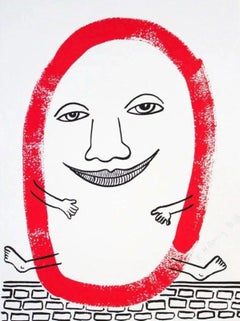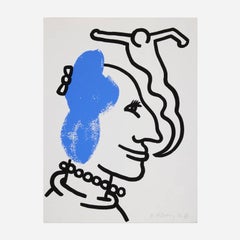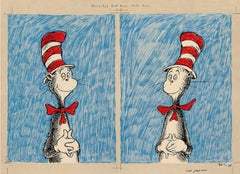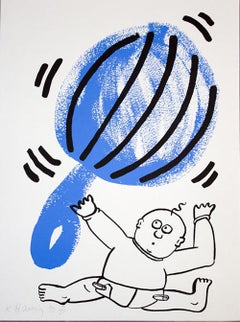Want more images or videos?
Request additional images or videos from the seller
1 of 16
Romero BrittoRomero Britto, I Love You - 2019, Sculptograph 3D MultiMedia Construction Signed2019
2019
$3,450List Price
About the Item
- Creator:Romero Britto (1963, Brazilian)
- Creation Year:2019
- Dimensions:Height: 30.5 in (77.47 cm)Width: 30.5 in (77.47 cm)Depth: 2 in (5.08 cm)
- Medium:
- Movement & Style:
- Period:
- Condition:
- Gallery Location:Pembroke Pines, FL
- Reference Number:1stDibs: LU2382214694542
About the Seller
4.9
Vetted Professional Seller
Every seller passes strict standards for authenticity and reliability
1stDibs seller since 2023
130 sales on 1stDibs
Typical response time: 19 hours
Authenticity Guarantee
In the unlikely event there’s an issue with an item’s authenticity, contact us within 1 year for a full refund. DetailsMoney-Back Guarantee
If your item is not as described, is damaged in transit, or does not arrive, contact us within 7 days for a full refund. Details24-Hour Cancellation
You have a 24-hour grace period in which to reconsider your purchase, with no questions asked.Vetted Professional Sellers
Our world-class sellers must adhere to strict standards for service and quality, maintaining the integrity of our listings.Price-Match Guarantee
If you find that a seller listed the same item for a lower price elsewhere, we’ll match it.Trusted Global Delivery
Our best-in-class carrier network provides specialized shipping options worldwide, including custom delivery.You May Also Like
Takashi Murakami Skateboard Deck (Takashi Murakami flowers)
By Takashi Murakami
Located in NEW YORK, NY
Takashi Murakami Flowers Skateboard Deck:
A vibrant piece of Takashi Murakami wall art produced as a limited series in conjunction with the 2017 Murakami exhibit: The Octopus Eats It...
Category
1980s Pop Art Prints and Multiples
Materials
Wood, Screen
James Rosenquist F-111 TRIPTYCH (ATOM) Limited Skate Modern Design Pop American
By James Rosenquist
Located in Madrid, Madrid
James Rosenquist - F-111 TRIPTYCH A (ATOM)
Date of creation: 2021
Medium: Digital print on Canadian maple wood
Edition: 100
Size: 80 x 20 cm (each skate)
Condition: In mint condition...
Category
2010s Pop Art Abstract Prints
Materials
Wood, Maple, Screen
$1,143
H 31.5 in W 7.88 in
Alien Workshop x Andy Warhol Foundation Skateboard Jacqueline Onassis 2011
By Andy Warhol
Located in Draper, UT
Alien Workshop Iconic Collection W/ Andy Warhol
Featuring portrait of Jackie Kennedy
Comes with Original Alien Skateboard sticker and wall mount.
Thi...
Category
2010s Pop Art More Art
Materials
Wood, Screen
$1,000
H 32.5 in W 8.5 in D 2 in
Alien Workshop x Andy Warhol Foundation Skateboard "Cow" 2011
By Andy Warhol
Located in Draper, UT
Alien Workshop Iconic Collection W/ Andy Warhol
Comes with Original Alien Skateboard sticker and wall mount.
From the Iconic Collection, depicting the...
Category
2010s Pop Art More Art
Materials
Wood, Screen
Shepard Fairey, Bureau of Public Works Twice Signed work on wood panel unique AP
By Shepard Fairey
Located in New York, NY
SHEPARD FAIREY
Bureau of Public Works (on Wood), 2004
Silkscreen on wood panel. Hand signed and annotated on both the recto and verso. In original handmade artist's frame.
24 × 18 in...
Category
Early 2000s Pop Art Abstract Prints
Materials
Wood, Screen
Shepard FaireyShepard Fairey, Bureau of Public Works Twice Signed work on wood panel unique AP, 2004
$15,000
H 24 in W 18 in D 1.5 in
With all My Flowering Heart Skateboard Triptych, 3 Limited Edition Skate Decks
By Yayoi Kusama
Located in New York, NY
Yayoi Kusama
With All My Flowering Heart (Triptych), 2014
Set of Three (3) Separate Limited Edition numbered skate decks on 7-ply Canadian maple wood
31 × 8 × 2/5 inches (each)
Hand ...
Category
2010s Pop Art Abstract Prints
Materials
Wood, Mixed Media, Permanent Marker, Screen
$3,500
H 31 in W 8 in D 0.4 in
Keith Haring crawling baby Skateboard Deck (Keith Haring skate deck)
By (after) Keith Haring
Located in NEW YORK, NY
Vintage Keith Haring Skateboard Deck featuring the artist's most recognized & iconic image, the Crawling Baby. This work originated circa 2013 as a result of the collaboration betwee...
Category
1980s Pop Art Abstract Prints
Materials
Screen, Wood
SUPREME skateboard deck set of 3 works (Supreme skate decks 2019)
By Supreme
Located in NEW YORK, NY
Supreme Skateboard Decks complete Set of 3 works, 2019:
A stand out skate triptych set featuring the Supreme logo in smoke letters. Features a printed World Famous Supreme logo. Each...
Category
21st Century and Contemporary Pop Art More Art
Materials
Wood, Screen
Price Upon Request
H 31.5 in W 8 in D 1 in
Damien Hirst Supreme Skateboard Deck
By Damien Hirst
Located in NEW YORK, NY
Damien Hirst Spin Series Skate Deck, Supreme 2009
Medium: Screenprint in colors on polychrome wood skateboard deck.
Dimensions: 31.1 x 7.68 in (78.99 x 19.51 cm).
Stamped signatur...
Category
1990s Pop Art More Art
Materials
Wood, Screen
Keith Haring Skateboard Deck (Keith Haring dragon)
By (after) Keith Haring
Located in NEW YORK, NY
Keith Haring Skateboard Deck c.2012:
Rare, out of print Keith Haring skate deck featuring one of the artist's iconic dragon images, set amidst a vibrant array of colors that really p...
Category
1980s Pop Art Sculptures
Materials
Wood, Screen, Lithograph
More From This Seller
View AllKEITH HARING 'THE STORY OF RED AND BLUE - 1990, L. pp. 128-13, SIGNED & NUMBERED
By Keith Haring
Located in Pembroke Pines, FL
Artist: Keith Haring
Title: Plate 5 from Story of Red and Blue (L. pp. 128-133)
Medium: Screen print in colors on wove paper
Sheet Size: 22 x 16.5 inches
Frame Size: approx 28.5 x 22...
Category
1980s Pop Art Figurative Prints
Materials
Screen
KEITH HARING 'THE STORY OF RED AND BLUE - 1990, L. pp. 128-13, SIGNED & NUMBERED
By Keith Haring
Located in Pembroke Pines, FL
Artist: Keith Haring
Title: Plate 6 from Story of Red and Blue (L. pp. 128-133)
Medium: Screen print in colors on wove paper
Sheet Size: 22 x 16.5 inches
Frame Size: approx 28.5 x 22...
Category
1980s Pop Art Figurative Prints
Materials
Screen
THE CAT'S DEBUT - DIPTYCH
By (after) Dr. Seuss (Theodore Geisel)
Located in Pembroke Pines, FL
Dr Seuss THEODOR GEISEL
"THE CAT'S DEBUT - DIPTYCH"
Limited Edition - Serigraph on Coventry Paper
Authorized Estate Edition
Edition Size:
850 Arabic Numbers
99 Patrons’ Collection
15...
Category
2010s Pop Art Interior Prints
Materials
Screen
KEITH HARING 'THE STORY OF RED AND BLUE - 1990, L. pp. 128-13, SIGNED & NUMBERED
By Keith Haring
Located in Pembroke Pines, FL
Artist: Keith Haring
Title: Plate 2 from Story of Red and Blue (L. pp. 128-133)
Medium: Screen print in colors on wove paper
Sheet Size: 22 x 16.5 inches
Frame Size: approx 28.5 x 22...
Category
1980s Pop Art Figurative Prints
Materials
Screen
Kenny Scharf, Flintstones, Screenprint, 1998
By Kenny Scharf
Located in Pembroke Pines, FL
Artist: Kenny Scharf
Title: Kenny Scharf, Flintstones, Screenprint, unsigned
Year: 1998
Medium: Screenprint, unsigned
Edition: 150
Size: 35 x 44 in. (88.9 x 111.76 cm)
Image Size: 3...
Category
1990s Pop Art Interior Prints
Materials
Screen
Robert-Indiana "Love is God-(2014)"
By Robert Indiana
Located in Pembroke Pines, FL
Robert Indiana
American, 1928–2018
Love Is God
Edition: 12/50
Silkscreen in 18 colors on 2-Ply Museum Board
Size: 32 × 32 in 81.3 × 81.3 cm
Signature: Hand-signed & numbered in penc...
Category
2010s Pop Art Interior Prints
Materials
Screen
Recently Viewed
View AllMore Ways To Browse
Michel Roux
World Cup Poster
Britto Love
Vintage Kiosk
Vintage Lake Poster
Vintage Sailing Poster
Yrjo Edelmann
Abstract 3d Wooden Wall Sculpture
Alex Katz Red
Antique Black Forest Wood Picture
Antique Pink Botanical Prints
Antique Sailing Prints
Bernardino Nocchi
Betye Saar
Buste De Femme
Canterbury Tales
Carlos Almaraz
Cccp Poster



